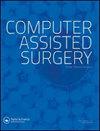保留交叉韧带的全膝关节置换术中胫骨组件旋转改变软组织平衡
IF 1.9
4区 医学
Q3 SURGERY
引用次数: 0
摘要
摘要我们的目的是了解在平衡型全膝关节置换术(TKA)中,使用不同的胫骨部件旋转标志是否会影响关节接触压力。12名患者接受了TKA(铁人三项CR,Stryker股份有限公司,新泽西州Mahwah),并使用无线传感器评估接触压力。使用功能对准技术进行机器人手臂辅助TKA,内侧和外侧隔室之间的间隙平衡。在试验胫骨部件分别旋转至Akagi线和Insall轴的情况下测量隔室压力。与屈曲10°、45°和90°时将胫骨部件旋转至Insall轴相比,将胫骨部件转动至Akagi线可使膝盖平衡的比例显著增加,接触压力显著降低(p<0.05)。屈曲10°时内侧隔室压力显著增加,当胫骨部件与Insall轴对齐时,所有位置的外侧隔室压力也是如此(p < 0.05)。观察到的两个界标旋转的平均差异为6.9°(范围4.1–9.1°)。与机械臂辅助TKA中的Insall轴相比,使用Akagi线旋转对齐胫骨部件降低了接触压力,改善了平衡,并减少了软组织释放的需要。本文章由计算机程序翻译,如有差异,请以英文原文为准。
Tibial component rotation alters soft tissue balance in a cruciate retaining total knee arthroplasty
Abstract Our aim was to understand whether using different landmarks for tibial component rotation influenced articular contact pressures in a balanced total knee arthroplasty (TKA). Twelve patients underwent TKA (Triathlon CR, Stryker Inc., Mahwah, NJ) and contact pressures were assessed using a wireless sensor. Robotic arm assisted TKA using a functional alignment technique was performed, with balanced gaps between medial and lateral compartments. Compartment pressures were measured with the trial tibial component rotated to Akagi's line and to Insall's axis respectively. Rotating the tibial component to Akagi's line resulted in a significantly greater proportion of knees being balanced and lower contact pressures than when the tibial component was rotated to Insall's axis at 10°, 45° and 90° of flexion (p < 0.05). Medial compartment pressures were significantly increased in 10° of flexion, as were lateral compartment pressures in all positions when the tibial component was aligned to Insall's axis (p < 0.05). The mean difference in rotation observed with the two landmarks was 6.9° (range 4.1–9.1°). Rotational alignment of the tibial component using Akagi's line reduced contact pressures, improved balance and reduced the need for soft tissue release when compared with Insall's axis in robotic arm assisted TKA.
求助全文
通过发布文献求助,成功后即可免费获取论文全文。
去求助
来源期刊

Computer Assisted Surgery
Medicine-Surgery
CiteScore
2.30
自引率
0.00%
发文量
13
审稿时长
10 weeks
期刊介绍:
omputer Assisted Surgery aims to improve patient care by advancing the utilization of computers during treatment; to evaluate the benefits and risks associated with the integration of advanced digital technologies into surgical practice; to disseminate clinical and basic research relevant to stereotactic surgery, minimal access surgery, endoscopy, and surgical robotics; to encourage interdisciplinary collaboration between engineers and physicians in developing new concepts and applications; to educate clinicians about the principles and techniques of computer assisted surgery and therapeutics; and to serve the international scientific community as a medium for the transfer of new information relating to theory, research, and practice in biomedical imaging and the surgical specialties.
The scope of Computer Assisted Surgery encompasses all fields within surgery, as well as biomedical imaging and instrumentation, and digital technology employed as an adjunct to imaging in diagnosis, therapeutics, and surgery. Topics featured include frameless as well as conventional stereotactic procedures, surgery guided by intraoperative ultrasound or magnetic resonance imaging, image guided focused irradiation, robotic surgery, and any therapeutic interventions performed with the use of digital imaging technology.
 求助内容:
求助内容: 应助结果提醒方式:
应助结果提醒方式:


